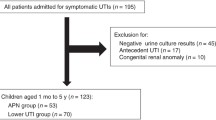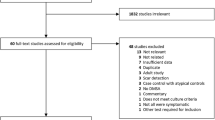Abstract
Neutrophil gelatinase associated lipocalin (NGAL) is a protein identified in human neutrophil granules. The aim of the study was to assess whether urine level of NGAL (uNGAL) could represent a novel, reliable marker of urinary tract infection (UTI) and to determine the optimal cutoff level for uNGAL to predict UTI in children. Sixty patients with symptomatic UTI and 29 healthy controls were enrolled the study. Urine NGAL was measured by enzyme-linked immunosorbent assay. A dimercaptosuccinic acid (DMSA) radionuclide scan was performed within 7 days in the patients with UTI in an attempt to distinguish pyelonephritis from cystitis. Mean uNGAL level was significantly higher in the UTI group than in the controls (91.02 ng/ml vs 14.29 ng/ml, p = 0.0001) and using a cutoff 20 ng/ml for uNGAL for diagnosis of UTI, sensitivity, and specificity were 97% and 76%, respectively [area under the curve (AUC): 0.979]. Mean uNGAL/creatinine ratio (uNGAL/Cr) was also significantly higher in the UTI group [201.81 ng/mg creatinine (Cr) vs 18.08 ng/mg Cr; p = 0.0001], and using a cutoff 30 ng/mg Cr for uNGAL/Cr for diagnosis of UTI, sensitivity and specificity were 98% and 76%, respectively (AUC: 0.992). In conclusion, both uNGAL and uNGAL/Cr can be used as a novel, sensitive marker for early prediction of UTI in the absence of acute kidney injury and chronic kidney disease, and the optimal cutoff value for prediction of UTI is lower than the values determined for acute kidney injury. Further investigations with larger patient groups are required to confirm our results.


Similar content being viewed by others
References
Hansson S, Jodal U (2004) Urinary tract infection. In: Avner ED, Harmon WEB, Niaudet P (eds) Pediatric nephrology, 5th edn. Lippincott Williams&Wilkins, Philadelphia, USA, pp 1007–1025
Jantausch B, Kher K (2007) Urinary tract infection. In: Kher KK, Schnaper HW, Makker SP (eds) Clinical paediatric nephrology, 2nd edn. Informa UK, UK, pp 553–573
Xu SY, Carlson M, Engström A, Garcia R, Peterson CG, Venge P (1994) Purification and characterization of a human neutrophil lipocalin (HNL) from the secondary granules of human neutrophils. Scand J Clin Lab Invest 54(5):365–376
Flo TH, Smith KD, Sato S, Rodriguez DJ, Holmes MA, Strong RK, Akira S, Aderem A (2004) Lipocalin 2 mediates an innate immune response to bacterial infection by sequestrating iron. Nature 432(7019):917–921
Berger T, Togawa A, Duncan GS, Elia AJ, You-Ten A, Wakeham A, Fong HE, Cheung CC, Mak TW (2006) Lipocalin 2-deficient mice exhibit increased sensitivity to Escherichia coli infection but not to ischemia-reperfusion injury. Proc Natl Acad Sci USA 103(6):1834–1839
Nguyen MT, Devarajan P (2008) Biomarkers for the early detection of acute kidney injury. Pediatr Nephrol 23(12):2151–2157
Xu SY, Pauksen K, Venge P (1995) Serum measurements of human neutrophil lipocalin (HNL) discriminate between acute bacterial and viral infections. Scand J Clin Lab Invest 55(2):125–131
Björkqvist M, Källman J, Fjaertoft G, Xu S, Venge P, Schollin J (2004) Human neutrophil lipocalin: normal levels and use as a marker for invasive infection in the newborn. Acta Paediatr 93(4):534–539
Fjaertoft G, Foucard T, Xu S, Venge P (2005) Human neutrophil lipocalin (HNL) as a diagnostic tool in children with acute infections: a study of the kinetics. Acta Paediatr 94(6):661–666
Ichino M, Kuroyanagi Y, Kusaka M, Mori T, Ishikawa K, Shiroki R, Kurahashi H, Hoshinaga K (2009) Increased urinary neutrophil gelatinase associated lipocalin levels in a rat model of upper urinary tract infection. J Urol 181(5):2326–2331
Pesce MA (2007) Reference ranges for laboratory tests and procedures. In: Kliegman RM, Behrman RE, Jenson HB, Stanton BF (eds) Nelson textbook of pediatrics, 18th edn. Saunders, Philadelphia, pp 2943–2954
Piepsz A, Colarinha P, Gordon I, Hahn K, Olivier P, Roca I, Sixt R, van Velzen J, Paediatric Committee of the European Association of Nuclear Medicine (2001) Guidelines for 99mTc-DMSA scintigraphy in children. Eur J Nucl Med 28(3):BP37–41
Hirsch R, Dent C, Pfriem H, Allen J, Beekman RH 3rd, Ma Q, Dastrala S, Bennett M, Mitsnefes M, Devarajan P (2007) NGAL is an early predictive biomarker of contrast-induced nephropathy in children. Pediatr Nephrol 22(12):2089–2095
Arinzon Z, Peisakh A, Shuval I, Shabat S, Berner YN (2009) Detection of urinary tract infection (UTI) in long-term care setting: Is the multireagent strip an adequate diagnostic tool? Arch Gerontol Geriatr 48(2):227–231
dos Santos JC, Weber LP, Perez LR (2007) Evaluation of urinalysis parameters to predict urinary-tract infection. Braz J Infect Dis 11(5):479–481
Mishra J, Dent C, Tarabishi R, Mitsnefes MM, Ma Q, Kelly C, Ruff SM, Zahedi K, Shao M, Bean J, Mori K, Barasch J, Devarajan P (2005) Neutrophil gelatinase-associated lipocalin (NGAL) as a biomarker for acute renal injury after cardiac surgery. Lancet 365(9466):1231–1238
Bennett M, Dent CL, Ma Q, Dastrala S, Grenier F, Workman R, Syed H, Ali S, Barasch J, Devarajan P (2008) Urine NGAL predicts severity of acute kidney injury after cardiac surgery: a prospective study. Clin J Am Soc Nephrol 3(3):665–673
Parikh CR, Jani A, Mishra J, Ma Q, Kelly C, Barasch J, Edelstein CL, Devarajan P (2006) Urine NGAL and IL-18 are predictive biomarkers for delayed graft function following kidney transplantation. Am J Transplant 6(7):1639–1645
Bolignano D, Lacquaniti A, Coppolino G, Donato V, Campo S, Fazio MR, Nicocia G, Buemi M (2009) Neutrophil gelatinase-associated lipocalin (NGAL) and progression of chronic kidney disease. Clin J Am Soc Nephrol 4(2):337–344
Sise ME, Barasch J, Devarajan P, Nickolas TL (2009) Elevated urine neutrophil gelatinase-associated lipocalin can diagnose acute kidney injury in patients with chronic kidney diseases. Kidney Int 75(1):115–116, author reply 116
Author information
Authors and Affiliations
Rights and permissions
About this article
Cite this article
Yilmaz, A., Sevketoglu, E., Gedikbasi, A. et al. Early prediction of urinary tract infection with urinary neutrophil gelatinase associated lipocalin. Pediatr Nephrol 24, 2387–2392 (2009). https://doi.org/10.1007/s00467-009-1279-6
Received:
Revised:
Accepted:
Published:
Issue Date:
DOI: https://doi.org/10.1007/s00467-009-1279-6




